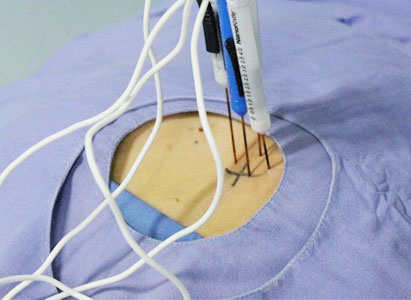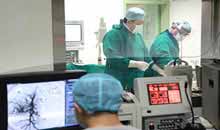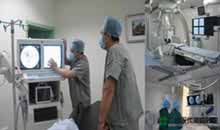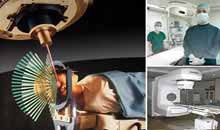
Nanoknife was approved by US FDA into clinical use and has passed EU CE accreditation. In recently years, it has been recognized as the latest, advanced cancer treatment and successively put into clinical use in over 100 core cancer hospitals all over the world.
It’s known that the first case of Nanoknife pancreatic cancer ablation is performed successfully in MCHG. Only with a few days, the tumor was gone the patient could get discharged. So amazing! In order to reveal the mystery of Nanoknife, we have an interview with professor Peng Xiaochi, the director of oncology from MCHG.
Nanoknife, safety and quick recovery,
According to Professor Peng, the most striking advantage of Nanoknife is rapidity and safety. Derived from Irreversible Electroporation (IRE), Nanoknife breaks the membrane of tumor cells with high voltage pulses from electrode probes of 1500 to 3000V, resulting in multiple permanent nano-meter electroporated holes and accelerating apoptosis of cancer cells. After that, phagocytes of human body will eliminate the dead tissues, thus to repair and regenerate normal tissues, so as to regain normal functions.
Besides, Nanoknife ablation causes in the ablated area no irreversible damage to important tissue structures like vessels, bile duct, nerves and ureter, etc. which will be well reserved after Nanoknife operation. Comparing with radiofrequency ablation and microwave ablation, Nanoknife is no-thermal ablation and won’t have damage to protein and DNA, won’t take away the thermal energy by the bloodstream which would weak the ablation effects. Moreover, Nanoknife ablation can completely cover the tumor no matter where it is located and in what sizes and shape. Meanwhile, after ablation, there is clear boundary between the ablated and unablated areas, which means no residual lesion and therefore lower the risk of recurrence. Doctors can observe the operation process to ensure the treatment effect and patient’s safety through real-time monitor. For those patients with permitted physical condition, they can get discharged from the hospital on the day of treatment or the other day.
Nanoknife, double the survival rate of advanced stage pancreatic cancer patients
Pancreatic cancer, a cancer with high degree of malignancy, is a kind of malignant digestive tumor of difficulty diagnosis and therapy, about 90% of them are originated from ductal adenocarcinoma. Moreover, accurate diagnosis is difficult and with a very high operative mortality and a low cure rate. It can achieve certain effects with physical ablation therapy while traditional chemotherapy and radiotherapy can just have a limited overall effect. Unfortunately, due to the characteristic of pancreas, using recent ablation therapy to deal with pancreatic cancers still has high complication rate and mortality. According to Professor Peng, the complication rate of radiofrequency ablation for the treatment of pancreatic cancers is about 28%-40%, and the mortality is 7.5%. Now, the three problems of pancreatic cancer physical ablation therapy are uncomprehensive ablation, blood vessel damaged and intestine wall and pancreatic duct injured, which can be greatly solved by Nanoknife. Professor Peng said, according to the advantage of Nanoknife, it is suitable for pancreatic cancer treatment. Referring to the study from American Surgical Association, most of the pancreatic cancer patients can have double survival rate.
Nanoknife, bring hope for cancer patients
Modern Cancer Hospital Guangzhou used to have 18 types of minimally invasive treatments which have reduced the side effects that brought by traditional chemotherapy and radiotherapy, but highlighting the advantages of small trauma, quick returns. However, for tumors closing to liver gate area, gall bladder, bile duct, pancreas and ureter, we would like suggest our newly, advanced Nanoknife ablation, which can make up the shortfall and offer more treatment options for the cancer patients.
The first case of Nanoknife pancreatic cancer ablation is performed successfully in MCHG, which is just the beginning of Nanoknife application. There would be more and more successful cases in dealing with involving liver cancer, gallbladder cancer and prostate cancer, etc.

























